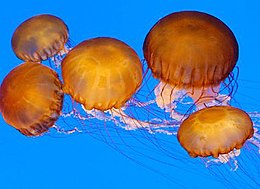Medusozoais acladein thephylumCnidaria,and is often considered a subphylum.[2][3]It includes the classesHydrozoa,Scyphozoa,StaurozoaandCubozoa,and possibly the parasiticPolypodiozoa.Medusozoans are distinguished by having a medusa stage in their often complex life cycle, a medusa typically being an umbrella-shaped body with stinging tentacles around the edge.[4]With the exception of some Hydrozoa (and Polypodiozoa), all are calledjellyfishin their free-swimmingmedusaphase.[3][5]
| Medusozoa Temporal range:Ediacaran– present,
| |
|---|---|

| |
| Pacific sea nettles,Chrysaora fuscescens | |
| Scientific classification | |
| Domain: | Eukaryota |
| Kingdom: | Animalia |
| Phylum: | Cnidaria |
| Subphylum: | Medusozoa |
| Classes[1] | |
| |
Evolution
editThe phylumCnidariais widely accepted as beingmonophyleticand consisting of two clades,Anthozoaand Medusozoa. Anthozoa includes theclassesHexacorallia,the hard corals, andOctocorallia,the soft corals, as well asCeriantharia,the tube-dwelling anemones. There is strong support for this group having been the first to branch off from the ancestral line.[6]
Medusozoa includes the classesStaurozoa,Cubozoa,ScyphozoaandHydrozoa,but the relationships between these are unclear. Analysis usingribosomal RNAsubunits suggests that within Medusozoa, Staurozoa was the first group to diverge, with Cubozoa and Scyphozoa forming a clade, a sister group to Hydrozoa. Further study involving the order of mitochondrial genes supports this view,[6]and their possession of linear mitochondrial genomes is striking evidence of the monophyly of medusozoans.[7]The stem group of Medusozoa also includesAuroralumina attenboroughii,the earliest known animalpredatorfrom the lateEdiacaran.[8]Burgessomedusafrom the mid-CambrianBurgess Shale is the oldest known free-living medusa (commonly known as jellyfish).[9]
The affinities of the classPolypodiozoa,containing the single speciesPolypodium hydriforme,have long been unclear. This species is anendoparasiteof fish eggs and has a peculiar life cycle. It has traditionally been considered to be a cnidarian because of its possession of nematocysts, but molecular studies using18S rDNAsequences have placed it closer toMyxozoa.Further studies involving28S rDNAsequences suggest that it is either part of the hydrozoan cladeLeptothecata,or a sister taxon to Hydrozoa, and does not group with myxozoans.[10]
Characteristics
editMedusozoans differ from anthozoans in having amedusastage in their life cycle. The basic pattern is medusa (usually the adult or sexual phase),planula larva,polyp,medusa. Symmetry is tetramerous, with parts in fours or multiples of four.[11]Themitochondrial DNAmolecules are linear rather than circular as in anthozoans and almost all other animals.[12]The cnidae, the explosive cells characteristic of the Cnidaria and used in prey capture and defence, are of a single type, there beingnematocystsbut no spirocysts or ptychocysts.[4]In contrast, the anthozoan life cycle involves a planula larva which settles and becomes asessilepolyp, which is the adult or sexual phase.[11]
Diversity
editThere is considerable divergence from the basic life cycle pattern among medusozoans.[11]
Scyphozoa is the group commonly known as "true jellyfish" and occur in tropical, temperate and polar seas worldwide. Scyphozoans generally have planula larvae that develop into sessile polyps. These reproduce asexually, producing similar polyps by budding, and then either transform into medusae, or repeatedly bud medusae from their upper surface in a process known asstrobilation.[4]
Cubozoa is a group commonly known as box jellyfish, that occur in tropical and warm temperate seas. They have cube-shaped, transparent medusae and are heavily-armed with venomous nematocysts. Cubozoans have planula larvae, which settle and develop into sessile polyps, which subsequently metamorphose into sexual medusae,[11]the oral end of each polyp changing into a medusa which separates and swims away.[4]
Staurozoa is a small group commonly known as stalked jellyfish. The animals remain attached to thesubstrateby a stalk at the opposite end from the mouth. Staurozoans can be regarded as large polyps that have partially differentiated into sexually mature medusae. These spawn gametes which develop into non-swimming planulae that crawl away to new locations.[4]
Hydrozoa is a large group of solitary and colonial cnidarians from both marine and freshwater environments worldwide. Hydrozoans exhibit the greatest variety of life cycles among medusozoans, with either the polyp or the medusa stage being missing in some groups.[4]In general, medusae are budded laterally from polyps, become mature and spawn, releasinggametesinto the water. The planulae may settle to become polyps or continue living in the water column as medusae.[11]
References
edit- ^Subphyla Medusozoa based on"The Taxonomicon – Taxon: Phylum Cnidaria".Universal Taxonomic Services. Archived fromthe originalon 2007-09-29.Retrieved2007-07-10.
- ^Marques, Antonio C.; Allen G. Collins (March 2004). "Cladistic analysis of Medusozoa and cnidarian evolution".Invertebrate Biology.123(1): 23–42.doi:10.1111/j.1744-7410.2004.tb00139.x.
- ^abZapata, Felipe; Goetz, Freya E.; Smith, Stephen A.; et al. (2015)."Phylogenomic Analyses Support Traditional Relationships within Cnidaria".PLOS ONE.10(10): e0139068.Bibcode:2015PLoSO..1039068Z.doi:10.1371/journal.pone.0139068.PMC4605497.PMID26465609.
- ^abcdefRuppert, Edward E.; Fox, Richard, S.; Barnes, Robert D. (2004).Invertebrate Zoology, 7th edition.Cengage Learning. p. 148.ISBN978-81-315-0104-7.
{{cite book}}:CS1 maint: multiple names: authors list (link) - ^Kayal, Ehsan; Bentlage, Bastian; Sabrina Pankey, M.; et al. (2018)."Phylogenomics provides a robust topology of the major cnidarian lineages and insights on the origins of key organismal traits".BMC Evolutionary Biology.18(1): 68.Bibcode:2018BMCEE..18...68K.doi:10.1186/s12862-018-1142-0.PMC5932825.
- ^abJ. Wolfgang Wägele; Thomas Bartolomaeus (2014).Deep Metazoan Phylogeny: The Backbone of the Tree of Life: New insights from analyses of molecules, morphology, and theory of data analysis.De Gruyter. p. 67.ISBN978-3-11-037296-0.
- ^Bridge, D.; Cunningham, C.W.; Schierwater, B.; et al. (1992)."Class–level relationships in the phylum Cnidaria: evidence from mitochondrial genome structure".Proceedings of the National Academy of Sciences USA.89(18): 8750–8753.Bibcode:1992PNAS...89.8750B.doi:10.1073/pnas.89.18.8750.PMC49998.PMID1356268.
- ^Dunn, F. S.; Kenchington, C. G.; Parry, L. A.; Clark, J. W.; Kendall, R. S.; Wilby, P. R. (25 July 2022)."A crown-group cnidarian from the Ediacaran of Charnwood Forest, UK".Nature Ecology & Evolution.6(8): 1095–1104.Bibcode:2022NatEE...6.1095D.doi:10.1038/s41559-022-01807-x.PMC9349040.PMID35879540.
- ^Moon, Justin; Caron, Jean-Bernard; Moysiuk, Joseph (2023-08-09)."A macroscopic free-swimming medusa from the middle Cambrian Burgess Shale".Proceedings of the Royal Society B: Biological Sciences.290(2004).doi:10.1098/rspb.2022.2490.ISSN0962-8452.PMC10394413.PMID37528711.
- ^Evans, Nathaniel M.; Lindner, Alberto; Raikova, Ekaterina V.; et al. (2008)."Phylogenetic placement of the Enigma tic parasite,Polypodium hydriforme,within the Phylum Cnidaria ".BMC Evolutionary Biology.8(139): 139.Bibcode:2008BMCEE...8..139E.doi:10.1186/1471-2148-8-139.PMC2396633.PMID18471296.
- ^abcdeCollins, A. G. (2002)."Phylogeny of Medusozoa and the evolution of cnidarian life cycles".Evolutionary Biology.15(3): 418–432.doi:10.1046/j.1420-9101.2002.00403.x.
- ^Kayal, Ehsan; Bentlage, Bastian; Collins, Allen G.; et al. (2012)."Evolution of Linear Mitochondrial Genomes in Medusozoan Cnidarians".Genome Biology and Evolution.4(1): 1–12.doi:10.1093/gbe/evr123.PMC3267393.PMID22113796.